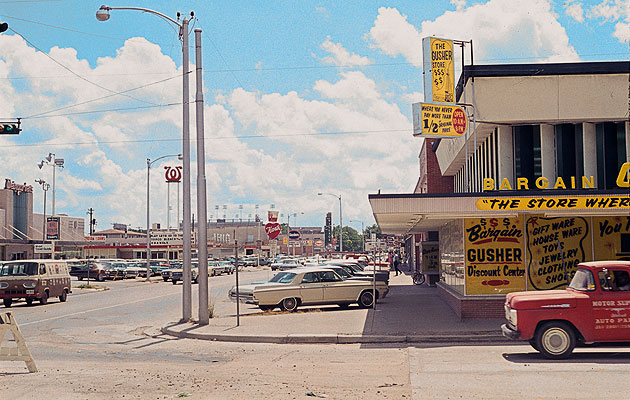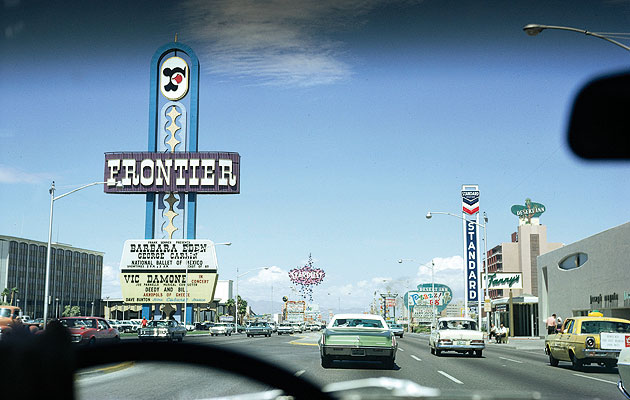|
Images of Las Vegas by Robert Venturi and Denise Scott Brown. The photos are part of a tourning exhibitionl, on show at the Museum of Contemporary Art, Los Angeles, 21 March – 20 June (image: © VSBA/Courtesy Museum Im Bellpark, Kriens, Switzerland) |
||
|
Four decade after the publication of Leargning From Las Vegas, Yale sets out ot measure the book’s legacy. Charles Hollad was there What happens in Vegas stays in Vegas, or so the saying goes. Clearly it’s not one that Robert Venturi and Denise Scott Brown subscribe to. Their 1972 book Learning From Las Vegas is one of the most famous tributes to the city’s charms. Learning From Las Vegas grew out of a studio that partners and married couple Venturi and Scott Brown taught at Yale University in 1968. Its celebration of Vegas combined with its attack on the architectural establishment of the day – including former Dean of Yale Paul Rudolph – made it a bitterly divisive polemic. Venturi and Scott Brown undoubtedly made some enemies in writing it and, despite their long and successful career, have arguably remained somewhat marginalised ever since. What We Learned – a Yale-organised exhibition with a three-day symposium (Architecture After Las Vegas) reflecting on the book nearly 40 years on – is, then, something of a homecoming. The exhibition’s ambiguous title foregrounds the difficulties Learning From Las Vegas still provokes. Is the “we” Venturi and Scott Brown themselves, or is it architectural culture as a whole? And what does it mean exactly to learn from a place like Las Vegas? During the symposium a vast array of academics, artists and architects (including Venturi and Scott Brown) attempted to unpick these questions. Some chose to look again at Las Vegas itself. Academic Ralph Stern examined it through its cinematic representation, as a city of escape overshadowed by both the desert and the bomb. Architect David Schwarz described the city’s origins and its growth as a recreational centre for workers on the Hoover Dam. He also showed that – far from being merely sprawl – Vegas is akin to a sequence of medieval walled villages linked along a boulevard. Art historian and curator Libby Lumpkin looked at contemporary Vegas and its attempts to use high architecture (Libeskind, Foster et al) to create a new, pedestrianised downtown. Other speakers focused on the book’s methodology. Katherine Smith lucidly dissected Venturi and Scott Brown’s relationship to artists such as Dan Graham, Ed Ruscha and Claes Oldenburg. Graham himself spoke about the profound influence of the couple on his work and of connections between the literal mirrors employed in his Alterations to a Suburban House project (1978/92) and the way the duo’s work subtly mirrors the suburban landscape around it. Peter Fischli (one half of Swiss art duo Fischli and Weiss) gave one of the most eloquent talks, drawing out intriguing connections between his interest in sub-cultures and kitsch source material and the way that the couple’s work tends to zoom in on the ordinary to make it unusual and strange. Somewhere in the middle of all this were Venturi and Scott Brown themselves. Venturi gave a short, modest and appropriately perverse talk about architecture and communication before Las Vegas. Stained-glass windows, frescoes and architectural decoration were about information first and art second, Venturi argued, just like Vegas. Scott Brown’s lecture was a gentle tour de force, putting the record straight on a number of issues, including their association with Po-Mo (different from postmodernism – the former is an architectural style whereas the latter is an attempt to evolve a new architecture out of modernism), the importance of studying things without necessarily agreeing with them and her own significant part in the practice’s remarkable body of work. Scott Brown’s marginalisation by architectural critics has echoed the lack of attention paid to the practice’s pioneering interest in advocacy planning, community consultation and the civil rights movement of the 1960s. One of the reasons architects dislike Learning From Las Vegas so much is that they remain in thrall to the ideal of the classical European city. Vegas’ automotive landscape of flashing signs and decorated sheds was anathema to them. Recognising this landscape as both new and valid, Venturi and Scott Brown attempted to describe it while withholding judgement. In doing so they committed two sins, one compounding the other. If it was bad enough that they gave credence to such a place to start with, it was even worse that they failed to clearly condemn it. But the importance of the book lies as much in the techniques of architectural research it pioneered as its subject matter. Film and photography were used extensively to catalogue a city best appreciated while on the move. These forms of representation also came free of architectural baggage. Such deadpan research can now be seen as extremely influential. Without them it’s difficult to imagine Rem Koolhaas’ Delirious New York (1978) or Harvard Design School Guide to Shopping (2002). They are also, as the exhibition shows, gorgeous artefacts in their own right. Ultimately, the value of this symposium was, like the book itself, not Las Vegas but a way of looking at the world. Venturi and Scott Brown’s triple strands of teaching, designing and research remain an inspirational model of artistic relevance and creativity. And behind it all are the buildings: delicate, tense and, sometimes, but not always, beautiful. It’s a beauty that is, as the symposium’s organiser Stanislaus von Moos said, all the more powerful for its acceptance of the ugly and the ordinary. This, ultimately, is what they learned.
Images of Las Vegas by Robert Venturi and Denise Scott Brown. The photos are part of a tourning exhibitionl, on show at the Museum of Contemporary Art, Los Angeles, 21 March – 20 June (image: © VSBA/Courtesy Museum Im Bellpark, Kriens, Switzerland) |
Words Charles Holland |
|
|
||
|
Images of Las Vegas by Robert Venturi and Denise Scott Brown. The photos are part of a tourning exhibitionl, on show at the Museum of Contemporary Art, Los Angeles, 21 March – 20 June (image: © VSBA/Courtesy Museum Im Bellpark, Kriens, Switzerland) The photograph is from The Archives of Robert Venturi and Denise Scott Brown, edited by Stadler and Martino Stierli, Chicago University Press, 2009. Next week we will run a gallery of these lush Vegas shots. |
||





















